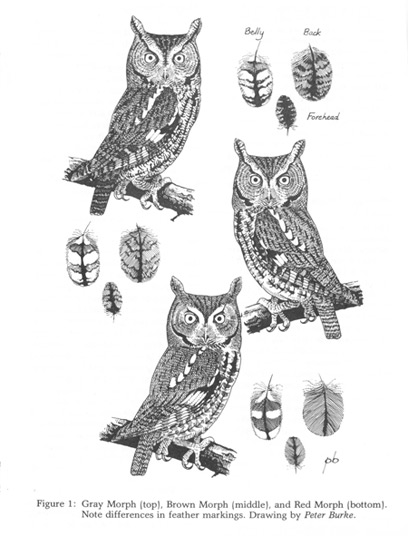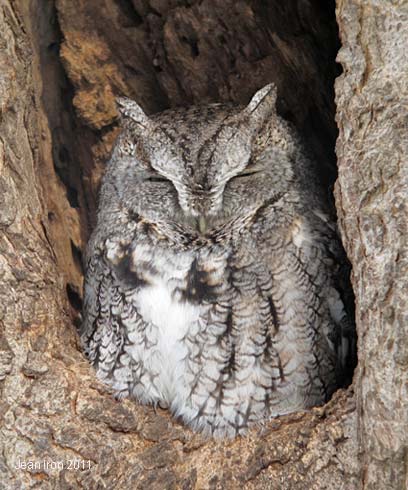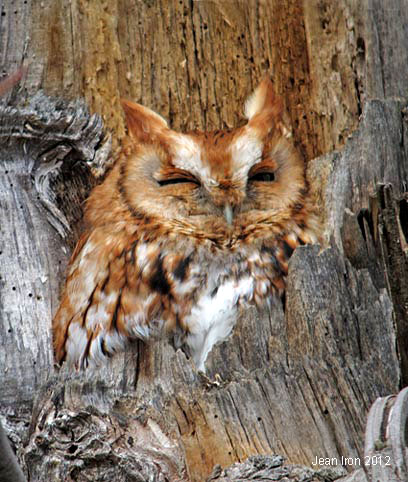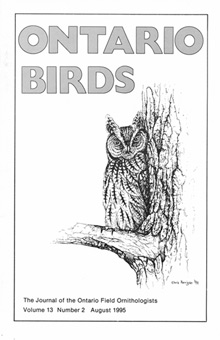|
|
|
Morphs of the Eastern Screech-Owl |
|
by
Ron Pittaway |
 |
|
Red morph Eastern
Screech-Owl at Point Pelee National Park on 11 May 2013 |
|
|
|
Revised January 2014. First
published in Ontario Birds 13(2): 66-71, 1995. |
|
|
|
Introduction |
|
The
Eastern Screech-Owl (Otus
asio)
is a widespread resident in southern Ontario south of the
Canadian Shield (James 1991). It prefers
small deciduous or mixed woodlots with mature trees and snags for roosting
and nesting. The Eastern Screech-Owl is strictly nocturnal.
During the day it usually perches close to the
trunk of a thick evergreen or roosts in a natural cavity or old flicker
hole,
rarely more than 10 metres up. On winter days it often sits in the entrance of a south-facing
hole, absorbing the warm sunlight.
If
disturbed, it retreats down the hole. Many birders are familiar
with its two common calls: a short horse-like whinny in the fall and winter,
and a toad-like trilling in the spring and nesting season.
Most
field guides illustrate and describe two colour morphs,
gray and red, of the Eastern Screech-Owl. Both
the gray and red morphs are illustrated in the National Geographic
Guide (Dunn and Alderfer 2011), and the Peterson Field Guide (2008). In addition,
there is a little-known brown or intermediate morph.
In this account I discuss the identification, frequency, genetics,
and some ecological differences of the three morphs of the Eastern
Screech-Owl in Ontario. The three morphs are illustrated in Voous (1988),
The
Sibley Guide to Birds (2000)
and by Peter Burke in Figure 1. |
|
|
|
Taxonomy |
|
Godfrey (1986) and James
(1991) list O.a. naevius
as the only subspecies of the Eastern
Screech-Owl
in Ontario.
A much paler subspecies
swenki
breeds in western
Manitoba,
intergrading with eastern naevius
at Winnipeg and Whitemouth. These locations are shown on the map on the inside cover
of The
Birds
of
Canada
(Godfrey 1986). Other
subspecies in North America
are
listed in the American Ornithologists' Union Check-list
(1957).
This
treatment of subspecies is in need of revision. I agree with DeBenedictis (1977) that
the most sensible treatment of subspecies is by Marshall (1967) who
lists five subspecies:
nominate O.a. asio
(includes naevius of the AOU 1957 and Godfrey 1986) of the
East,
O.a. maxwelliae
(includes swenki
of the AOU 1957 and Godfrey 1986) of the Great Plains, O.a.
floridanus
of Florida west to
Mississippi, O.a.
hasbrouchi
of Texas, and O.a.
mccallii
of the Rio Grande Valley. The Eastern Screech-Owl account in The
Birds of North America On-line (1995) has a map of the distribution
of the currently recognized subspecies.
Morphs vary in hue depending on whether the subspecies is dark or
pale. For example, compare the eastern gray morph with the paler
western gray morph maxwelliae (includes swenki) on
page 287of the National Geographic Guide (Dunn and Alderfer 2011).
Similarly,
the red morph of the western maxwelliae is paler than the
eastern red morph.
Why are
the three morphs of the Eastern Screech-Owl not considered
subspecies?
Subspecies are forms having separate breeding
ranges,
interbreeding where their ranges meet. Morphs are forms occurring in the same breeding range,
with different morphs even occurring in the same brood.
The third part of the scientific name is the name of the subspecies,
for example,
Otus asio
naevius
is the subspecies in Ontario (AOU 1957). It has three morphs.
Morphs do not have scientific names. In screech-owls,
the morphs are more recognizable than the subspecies. |
 |
|
|
Figure
1. Three morphs of the Eastern Screech-Owl by Peter Burke published in Ontario Birds
Vol.13 No. 2,
1995 |
|
|
|
|
Plumages, Molts, Aging and Sexing |
|
|
The sexes are similar in all
ages and plumages. Juveniles (juvenals) in summer are narrowly barred all over,
except on the wings and tail which are much like the adult.
Gray and red morph juveniles usually are distinguishable in the field.
See the illustration of the gray morph juvenile on page
287of the National Geographic Guide (Dunn and Alderfer 2011). In late
summer and early fall,
juveniles undergo a partial molt to first year (first basic) plumage,
retaining the juvenile wings, scapulars and tail. First
year birds and adults (definitive basic) are similar in appearance.
First year birds (when they are one year old) and adults undergo a
complete
molt from late July to mid-November to fresh adult plumage.
Colours become faded and dull on worn birds by the next spring and
summer.
See Bent (1938) for excellent descriptions of plumages and molts in
juveniles,
first year birds and adults. Partial and total albinos are known in this species
(Holt et al.
1995).
|
 |
|
|
Figure 2. Data from
Table 1 in Owen (1963) |
|
|
|
|
Morph Genetics |
|
|
The
three morphs vary in colour and in the extent and pattern of
the
dark
markings
on
their
feathers. See Figure 1. Out of a total of 1320 specimens
examined
by
Owen
(1963) from throughout the range,
54
percent
were gray, 38 percent red and 8 percent intermediate (brown). In his
study, Owen divided 833 screech-owls from selected areas into six
colour types, grading from gray to red: two gray, two intermediate
(brown), and two red. Figure 2 shows the strong bimodal (gray and
red) distribution of the morphs and the continuous variation between
the morphs. The gray, brown and red morphs are not linked to age,
sex or subspecies. A bird is hatched a certain morph and remains
that colour all its life. All three morphs have been observed in the
same brood (Hrubant 1955,
Smith 1993).
There are two main theories for the three
morphs: (1)
the gray and red morphs are due to one gene having two alleles (forms) with red
dominant over gray, with the brown morph due to other modifying genes;
(2) the morphs are due to one gene having three alleles with a
graded order of dominance, red over brown over gray (Hrubant 1955,
Owen 1967,
VanCamp
and Henny 1975, DeBenedictis 1977). There is no clear resolution
of which hypothesis is correct. Perhaps
the variation observed in
the
morphs is under the control of more than one gene. |
 |
|
|
|
Gray Morph
|
|
The
gray
morph is the most
common
morph in Ontario and throughout the northern part of the
Eastern
Screech
Owl's
range.
See Figure
3. Based on specimens in the
Royal
Ontario
Museum,
Martin (1950) reported that 81 percent of the population in Ontario
was of the gray morph.
Martin did not recognize a brown morph, apparently lumping gray and
brown birds in his study. Gray morph birds in fresh plumage in fall are a clear gray,
becoming tinged with brown on worn and faded birds in spring and
summer (Kaufman 1990).
Typical
brown morphs are a richer cinnamon-brown colour,
including the facial disc. |
|
|
Figure 3. Gray morph
Eastern Screech-Owl in Toronto, 20 January 2011 |
|
|
|
|
Red Morph |
|
|
Red
morph screech-owls are bright, “a gorgeous rufous like a red fox"
(Marshall 1967). Red morphs comprise
about 19 percent of the Ontario population,
based
on
specimens in the Royal
Ontario
Museum
(Martin
1950).
Red
birds are uncommon in the northern parts of the screech-owl's range.
Why? The reason may be that red morph birds have a lower survival
rate than gray birds during unusually cold and severe
winters. Plumage colour is correlated with thermal adaptation.
Mosher and Henny (1976) found under laboratory conditions at -5°
C and -10°
C that red
birds
had
significantly
higher metabolic requirements than gray birds.
Differential mortality was observed in an Ohio study by VanCamp and
Henny (1975). They report that 44 percent more red birds died than
gray birds during the particularly
severe winter of 1951-1952. Perhaps the
percentage of red
birds declined in southern Ontario
during the winter
of 1993-1994,
one of the snowiest and coldest
winters on record! Similarly, Gullion and Marshall (1968) in Minnesota
found a differential mortality between red and gray morph Ruffed Grouse (Bonasa
umbellus)
related
to winter survival. Why red coloration is linked to winter
survival
in these two species is unknown.
There
are two additional differences between gray and
red
morph
birds that are noteworthy. First, Kay McKeever (pers. comm.) reports that "the feathering on the legs of red birds appears to be less
dense
than
on grays". Second, red birds spend more time in cavities
during
cold
winter days, 80 percent (red) versus
38 percent (gray) (Voous 1988). Bruce Di Labio (pers. comm.) reported that the red bird of a mixed
pair
he
observed for many years in Ottawa often was more difficult to
find
in winter than the gray bird. |
 |
|
|
Figure 4. Red morph
Eastern Screech Owl at Burlington, 27 Feb. 2012 |
|
|
|
|
Brown Morph |
|
|
The
brown
or intermediate morph is by far
the
least common form in screech-owl populations,
except
in
Florida
where intermediates make up to 40 percent of the
population
(Owen
1963).
Based
on
247
screech-owls
from Ontario admitted to The Owl Foundation in Vineland,
only
six
or 2.43
percent were classified as brown morphs by Kay
McKeever
(Penak
1986).
Bull (1974)
examined
144
New York specimens in eight state museums; only four or 2.78 percent
were brown morph birds.
Peter
Burke
(pers. comm.) and Tim Dyson
banded an intermediate morph screech-owl on 4 March 1995 near
Peterborough.
Peter described it as “very beautiful indeed. The overall coloration was dry gray-brown,
with highlights
of bright rufous-reddish areas on the scapulars and
breast feathers”.
Kay McKeever (pers. comm.) of The Owl Foundation
in Vineland describes the brown morph as a "warm brown like a saw-whet
owl".
Ross James (in litt.) of
the Royal Ontario Museum says "there is considerable variation in
the brown coloration depending on whether it tends towards
reddish
or grayish. In general, the brown is more of a cinnamon
or tawny brown as opposed to a dark chocolate, reflecting a mix of reddish tones on one side
and lighter or whiter gray on the other".
In New
England the brown morph is described as being
chocolate brown in colour (Smith 1993), but intermediate birds from
Ontario in the ROM are not chocolate brown (Ross James,
pers. comm.). Similarly, Kay McKeever (pers.
comm.)
has never seen a chocolate brown Eastern Screech-Owl.
Be
aware that brown
morph screech-owls could be overlooked as
gray birds given
only
a frontal (ventral) view. The rich brown coloration is most apparent on the upperparts
(dorsum), the side least often
viewed.
When
identifying a brown morph, keep in mind that recently molted
gray
morphs
in fall in fresh plumage are clear gray above, but become tinged with brown on worn
and faded birds by
spring
and summer (Kaufman 1990).
|
 |
|
|
Figure 5. Brown morph
Eastern Screech-Owl in Toronto on 1 March 2008 |
|
|
|
|
Summary |
 |
|
Three
recognizable
forms
of
the Eastern
Screech-Owl
occur
in Ontario:
gray,
brown
and red morphs. The gray morph is the most common, comprising about
80 percent of the Ontario
population;
the red
morph is less than 20 percent;
and the brown morph is the rarest, comprising less than three percent. Typical
(most) individuals of each morph are easily
recognizable,
but
note
that
there
is
continuous
variation between red and gray birds. |
|
|
|
Acknowledgements |
|
For
advice and assistance
in the preparation of this article, I thank Peter Burke,
Bill Crins,
Bruce Di Labio, Tim Dyson,
Earl
Godfrey, Michel Gosselin, Mary Ellen Hebb, Jean Iron, Alvaro
Jaramillo,
Ross
James, Kay McKeever, Dwight Smith, Ron Tozer
and Mike
Turner.
Peter Burke's
illustration of the three morphs is a masterpiece that greatly enhances the
text.
|
|
|
Figure 6. Front cover of
Ontario Birds Vol.13 No. 2. 1995. Illustration by Christine
Kerrigan |
|
Literature Cited |
|
|
American
Ornithologists' Union. 1957.
Check-list
of North
American
Birds,
5th Edition. American Ornithologists' Union, Washington, D.C.
Bent,
A.
C.
1938.
Life
Histories
of North American Birds of Prey. Part 2. United States National Museum Bulletin 170. Washington, D.C.
Bull. J.
1974.
Birds
of New York State. Doubleday/Natural History Press, Garden City. New York.
DeBenedictis,
P.
1977.
Gleanings
from
the
technical
literature.
Birding
9:
238-241.
Dunn, J.L. and J. Alderfer.
2011. 6th Edition. Field Guide to the Birds of North America.
National Geographic. Washington, D.C.
Gehlbach, Frederick
R. 1995. Eastern Screech-Owl (Megascops
asio), The Birds of North America
Online (A. Poole, Ed.). Ithaca: Cornell Lab of Ornithology;
Retrieved from the Birds of North America Online:
http://bna.birds.cornell.edu/bna/species/165/articles/introduction
Godfrey,
W.E.
1986.
The
Birds
of
Canada.
Revised
Edition.
National Museum of Canada, Ottawa.
Gullion,
G. and W.H. Marshall. 1968. Survival of the Ruffed Grouse in a boreal forest. Living Bird 7: 117-167.
Holt,
D.
w.
M. W.
Robertson
and
J.H.
Ricks.
Albino
Eastern Screech-Owl. Otus asio. Canadian Field-Naturalist 109: 121-122.71
Hrubant,
H.E.
1955.
An
analysis
of the
color
phases
of the Eastern Screech Owl. Otus asio, by
the
gene
frequency
method.
American
Naturalist
89:
223-230.
James,
R.D.
1991.
Annotated
Checklist
of
the
Birds
of Ontario.
Second
Edition. Life Sciences Miscellaneous Publications. Royal Ontario Museum, Toronto.
Kaufman,
K.
1990.
A
Field
Guide
to
Advanced
Birding.
Houghton
Mifflin
Company,
Boston.
Marshall,
J.T.
1967.
Parallel
variation
in
the
screech
owls
of
North
and
Middle
America.
Western
Foundation
of Vertebrate Zoology Monograph 1: 1-72.
Martin,
N.D.
1950.
Color
phase
investigations
on
the
Screech
Owl
in Ontario. Canadian Field-Naturalist 64: 208-211.
Mosher,
J.A.
and C.J
Henny.
1976.
Thermal
adaptiveness
of plumage colors in Screech Owls. Auk 93: 614-619.
Owen,
D.F.
1963.
Polymorphism
in the
Screech
Owl
in eastern North America. Wilson Bulletin 75: 183-190.
Penak,
B.L.
1986.
Status
Report
on
the Eastern
Screech
Owl
in Canada.
Committee
on
the
Status
of
Endangered
Wildlife in Canada, Ottawa.
Peterson,
R.
T. 2008.
Peterson
Field
Guide
to Birds
of North America. Houghton Mifflin Company, Boston.
Robbins,
C.S.,
B. Bruun and H.S. Zim. 1983.
Birds
of
North
America.
Golden
Press,
New York.
Sibley, David A.
2000. The Sibley Guide to Birds. Alfred A. Knoft, New York.
Smith,
D.G.
1993.
Eastern
Screech
Owls.
Bird
Watcher's
Digest
16 {11:32-39.
VanCamp,
L.F.
and C.J.
Henny. 1975. The Screech Owl: Its Life History and Population Ecology in Northern Ohio. North American Fauna, Number 71. United States Department of the Interior, Fish and Wildlife Service.
65 pages.
Voous,
K.H.
1988.
Owls
of the
Northern
Hemisphere.
Collins,
London.
Ron
Pittaway,
9
Lichen Place, Toronto ON M3A 1X3. |
|
|
|
|
|
|
|